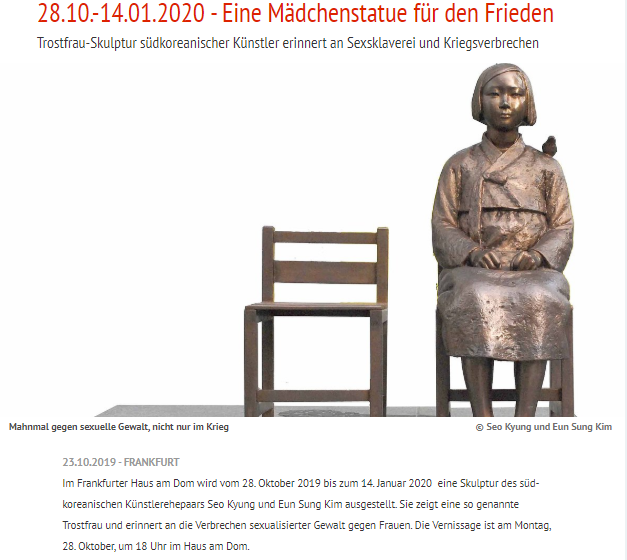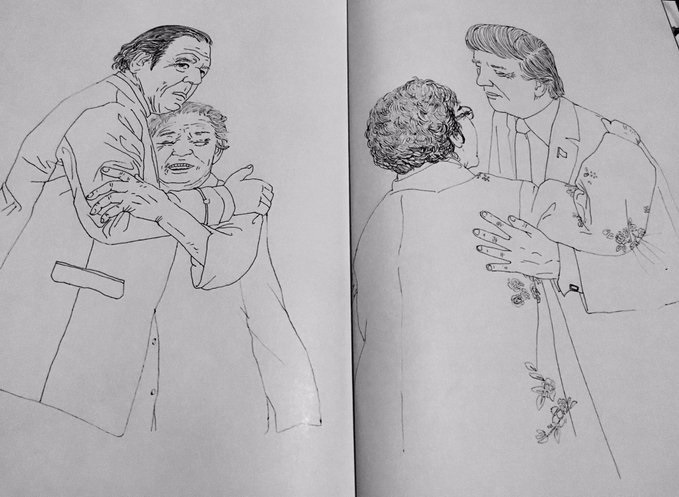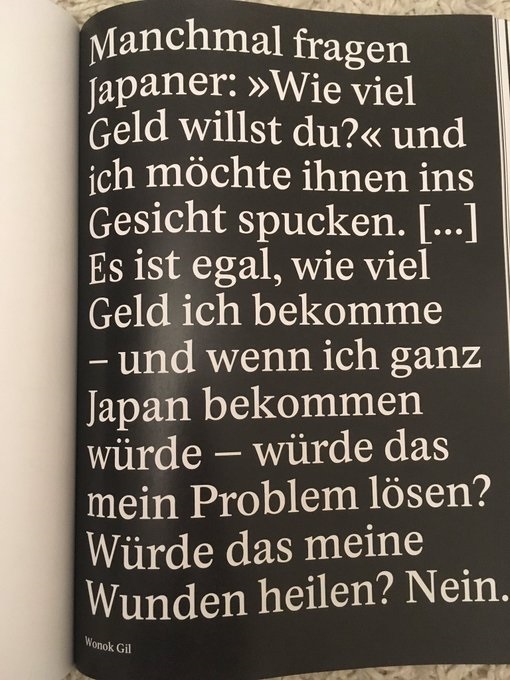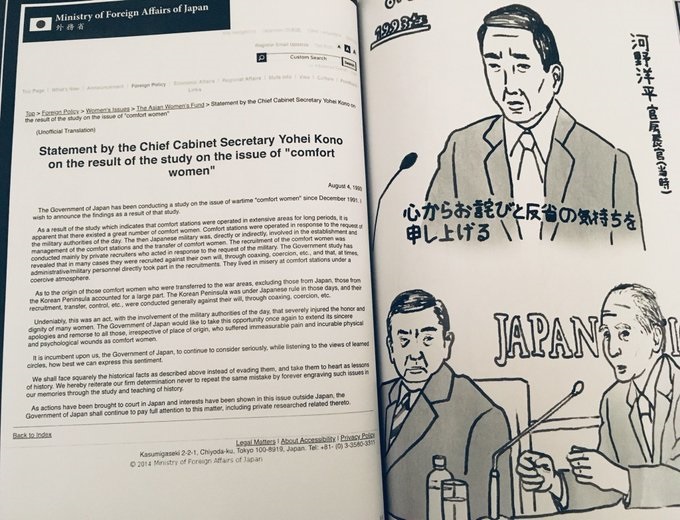[Japanese]
November, 2019
Hidemi Nagao ( Former Civil and Media Liaison Officer of the Commander U.S. Naval Forces, Japan, Novelist and Non-fiction Writer )
COMFORT WOMEN ISSUE—WOMEN’S REVOLT
1. Overview
This essay starts with observations of religions and rituals in Japan and the Korean Peninsula. It then focuses on their relations with women. Next is a brief review of the comfort women issue, a protracted conflict between Japan and South Korea. Presented finally are a few conclusions that may not please the knowledgeable in some sector.
There are two kinds of people in society. Highlighted herein is to explain them by simply clarifying two terms; ‘Understanding’ and ‘Interpreting.’ To understand is to have a clear or complete idea of something, whereas, to interpret is to present something in understandable terms. It follows interpretation is oriented to a certain direction in the light of individual belief, judgment, or circumstance. An example is given; people tend to think “It would be better or convenient for me to interpret this matter this way.” What is prioritized there is not facts but one’s social status. That is why there are two kinds of people, which is reality of life.
2. Religions
There are numerous religions in the world today. In terms of the number of followers, Christianity tops with more than two billion while Islam, Hinduism, and Buddhism come next with at least several hundred million. Each of the top four is not a monolithic organization. Christianity, for example, has schools of Catholic, the Church of England, the Greek Orthodox Church, Protestant, etc. There are also countless indigenous religions and group-oriented religions in the globe.
Simply speaking, religions can be classified, by objects of worship, as polytheism, monotheism, ancestor worship, nature worship, animism, shamanism, etc. Some of them have scriptures/teachings and others do not. Most of them perform a set form of rituals.
The number of people without religious faith is said to be several hundreds of millions, which is on the rise in the world.
2.1 Japan
There are two major religions in Japan; Shintoism and Buddhism. Shrines and temples are abundant in every corner of the country.
Shintoism does not have scriptures or teachings, nor its founder. It is a sort of a tribal religion to worship mythology, a multitude of spirits in natural things, and ancestors.
Buddhism to practice teachings of Buddha was introduced to Japan through the Korean Peninsula in the 6th century. It began to be pervasive among the public at large in the 12th century, however, both Buddhism and Shintoism have been coexisting in harmony until today.
As for other religions, Confucianism came from China through the Korean Peninsula before Buddhism did. It was, however, taken rather as a norm of thought and behavior than a religion. Christianity landed in the nation in the 16th century. Its followers are less than 1% of the population today.
Japanese people are supposed to carry out marriage and funeral ceremonies according to their individual religions. One exception is a wedding ceremony, most of which begin with a Shinto ritual and end with a Christian one. No one considers it as incoherent.
Magic has long been observed in Japan. It is not foreign to Shintoism and Buddhism. Those who practice it deliver what spiritual beings state, through a supernatural act or a parapsychological phenomenon such as evocation. They are called spirit mediums or shaman.
2.2 Korean Peninsula and South Korea
Buddhism and Christianity in South Korea are top two religions with followers of more than 55% of the population. The rest are said to be without religious faith, excepting some indigenous ones.
Buddhism began to propagate in the Korean Peninsula from the 7th century. It became the national religion in the Goryeo Dynasty (10th – 14th centuries). The Joseon Dynasty (14th – 19th centuries)—which took over Goryeo—denounced Buddhism while elevating as a national religion the Zhu Xi school of Confucianism. The dynasty made it the sole academic discipline and used it as political construct to govern the peninsula. Despite its significant influence still looming over the South Korean society of today, the Zhu Xi school has no longer many followers as a religion.
Christianity did not get any attention of the people until the 19th century. Followers gradually increased over the years since then. 33 men jointly read their declaration of independence during the 3.1 Independence Movement in 1919. 16 of them were Christians. Yu Gwan-sun, one of the independence movement activists who died in Seodaemun Prison a year and a half later was also a Christian and so were her parents.
Though Buddhism and Christianity are respectively observed in South Korea, both are said to have been inextricably intertwined with “mudang” or shamanism.
3. Rituals
Rituals are ceremonies to worship gods and ancestors to appreciate their protection of the people’s life and to console the dead.
Since the dawn of history, they were closely linked with religions and those who govern the people. People gathered to present foods, and offer prayers, dance, and music. Rituals also serve to pray for recovering of a person from illness, a good climate, fortune for battles, and good harvest. Those who perform rituals are called shaman, spirit mediums, diviner, and the likes. When a nation/dynasty was established and its ruler adopted a specific religion to adhere to, government and religion became inseparable. As a result, messages shaman delivered often influenced government policies.
3.1 Amaterasu-omikami appears as the most important goddess in Japanese mythology. She is said to be one of the founders of the nation whose descendant, several generations apart, is Emperor Jinmu who established Japan’s Imperial Household. According to Kojiki (Records of Ancient Matters) and Nihonshoki (the Chronicles of Japan), Amaterasu-omikami is a goddess of the sun and a shaman. The two official records above—written in early 8th century—refer to a divinatory method called “futomani” which used a shoulder blade of a male dear for fortune-telling. After a method to use a turtleback was introduced to Japan from China, a Shinto administrator of the imperial court practiced divination by use of the turtleback.
During the Kofun Period (when large burial mounds were built in the 3rd – 7th centuries), it is said there was a Hime-Hiko system, in which Hime (women) as administrators of rituals exercised more authority over Hiko (men) who were responsible for government. A research indicates the ratios of influential men and women buried in mounds were 6 to 4 or 8 to 2. In other words, Hime’s status was reasonably high. As years went by, Hime’s social status declined but Hime as Miko (shaman) have survived to this day and they practice rituals for prayer, fortune-telling, divination, and evocation. A male Miko is called “geki.” A woman who plays a supplementary priestess in shrines is generally called Miko since modern times.
Today, it is still a custom for men and women, regardless of ages, to pay a visit to a shrine/temple on the new year day for praying. There was once a custom for women to visit a shine/temple a hundred times in a day—repetitively walking from the entrance gate to the main hall and back—to wish for good fortune, etc.
3.2 The Korean Peninsula also has a mythical ruler named Dangun who as a descendant of the sun god reigned for more than 1,000 years. He is said to be Mudan (shaman) and therefore the Koreans practiced rituals for the sun god since those legendary years. Mudang, through the end of the Goryeo Dynasty, played a major role for both the dynasty and for the public in the same way as Miko did in Japan. Most mudang were female yet there were also many male mudang who were also called “baksa.” Upon the establishment of the Joseon Dynasty, mudang’s status was lowered to an underclass (Cheonmin, vulgar commoners) due to the flourishment of the Zhu Xi school. The people at large had and still have such a big want for mudang, which has survived until today.
Fact of the matter is it was costly to ask a mudang to pray for recovery of a family member from illness, etc. It was always the women who took pains in arranging a ritual by the mudang. (Note: There were 12,300 mudang in the Korean Peninsula as of August 1930. There were 129 medical facilities, both public and private, with 1,791 physicians and 4,472 physician assistants, most of which were in urban areas. The population was 19.68 million as of 1930 according to a Government General of Korea record.)
4. Status of Women
Now that introductory discussions are done, it is time to discuss serious issues.
Emperor Naruhito is the 126th emperor of Japan. History saw eight empresses for ten periods. The first one was Empress Suiko (592-628) and the latest one was Empress Gosakuramachi (1762-1770). The shortest reign was about seven years while the longest one was about 35 years. Some of them had spouses and others stayed single.
It is true that maintaining the imperial lineage had brought about tangles of political machinations in the imperial court before. Similar struggles had also been observed while keeping the Shogunate power intact. Truth is there was no female Shogun in history. Some exceptions were a few female lords and clan heads in the 16th-17th centuries. Since the Meiji Restoration, no woman has become a prime minister of Japan for the past 150 years.
In the meantime, no queen ruled the Korean Peninsula since the days of King Dangun to the 20th century. South Koreans, however, enthroned a woman president in 2013, the first female leader in East Asia.
4.1 Japanese Women
Excepting Amaterasu-omikami, eight empresses, and wives of Jushu (Gunma Prefecture of Japan where silkworm cultivation for silk production was going strong), the status of women was low. Due to the influence of Confucianism, patriarchy and primogeniture were social norms, especially since the days of the samurai reign. The most important agenda for a samurai—other than serving his lord—was to maintain his family name and “fuchi” (appropriations given by his lord or Shogun). If the samurai did not bear a son, by marriage or by outside of marriage, he lost the samurai status. The samurai had to adopt a son with the help of his kin. In other words, daughters did not have a right to succeed her family.
In the case of merchants and farmers, they did not strictly follow primogeniture. Though a direct heir often inherited the family estate, the heir’s siblings (brothers and sisters) sometimes shared inheritance. In the absence of sons, a daughter married a man brought into the family to continue the family business.
The imperial rule was restored in 1868. Those who were in government were former samurais in early years. Throughout the periods of international conflicts such as the Sino-Japanese War to the Pacific War, generals and admirals engaged themselves in politics; the male-dominant society had not seen any change in the women’s status.
Consequently, such sayings as “Fusho-fuzui” and “Onna wa sangai ni ie nashi” were prevailing in modern times, which respectively means ‘The wife is to follow the husband’s lead,’ and ‘A woman always obeys her parents, her husband, and her children as she grows old.’ There was a time until recently when women’s marriage in Japan was touted as ‘a permanent employment’ and the life of a full-time housemaker was to come with ‘three meals a day with a daytime nap schedule.’ It was customary for people to refer to a wife as “Oku-sama” or “Oku-san,” which means she is in the ‘back of the house.’ When a husband referred to his wife to other people, he addressed her as “Kanai,” which literally means ‘inside the house.’
The old Civil Code states, “The spouse of the deceased becomes an heir at all times. When there are other heirs …, the spouse’s inheritance order will be the same as other heirs. … Children of the deceased will be successors. … When two or more heirs exist, they will share the estate.” The code did not prejudice male or female. As for the family’s genealogical chart, ritual apparatus, and family tomb, custom dictates who should inherit them unless the deceased stated otherwise in last will. The Civil Code of today follows the old one as far as succession is concerned.
Upon the death of a person, his/her family holds a funeral ceremony and erects a tomb unless one is available. The head family carves the name of the deceased on the side of the tomb stone or on a stone marker. A collateral family may choose to erect a new one, in which case, the branch head inscribes his/her name on the stone/marker as the founder. Thereafter, names of direct descendants will be carved on it, regardless of gender, excepting daughters who married out.
4.2 Korean Peninsula Women
Korean women would have been similar in social status to Japanese women until modern times. While samurai clans and military ruled the society in Japan, it was the munban of the yangban who oversaw the dynasty administration. This difference might have affected the status of the Korean women in a more adverse way than that of the Japanese women.
For, the Zhu-Xi school became the sole political/philosophical construct to govern the peninsula for as long as 500 years until the Joseon Dynasty ended. The yangban, consisting of the munban and the muban (soldiers), were the dynasty business administrators. It was the munban—the intellectuals who passed the gwageo exams that had been modeled on the imperial examinations of China—who ruled the peninsula. They firmly established the male-dominant hierarchical society and institutionalized a manual for ceremonial functions as “mun-gong-ga-rye.” Meantime, they emphasized in the lineage system the clan of the extended families, “bon-gwan,” by linking the birthplace of the founder. As such, the patriarchal society upholding the primogeniture continued to survive.
A Japanese woman adopts her husband’s family name upon marriage and detaches from her lineage. A Korean woman, on the other hand, keeps her maiden name after marriage. Though this practice may put more weight on her family than on her spouse’s family, it can be interpreted, in a way, to keep her staying out of his lineage all her married life.
There are other examples to indicate a strong influence of the patriarchal society. A married woman is often addressed not by a given name but by her surname or hometown name. If she has a son named Yeongil, neighbors call her “Yeongil eomma (Yeongil’s mother).” Her keeping the family name does not necessarily mean that she can freely participate in her family rituals. Without express, voluntary permission from her mother/father-in-law, she cannot visit her family on such auspicious days as the lunar new year day (Seol or Seollal) or the 15th day of the 8th lunar month (Chuseok or Hangawi). Additionally speaking, a married woman was commonly called ansaram (a person inside) or jipsaram (a person in the house). As a side note, the women—who lived through those years when agriculture was the main industry—could not participate in village autonomy as it was the men who governed the community.
It was and it is still partially a custom for the Koreans to purchase a small mountain site to build a tomb for the deceased. They first determine the tomb location, using feng shui (Chinese geomancy), then bury a coffin and build a mound. A tomb is prepared for each deceased person. Being erected aside to it is a stone marker with the names of a family head and descendants. The wife of the deceased had her name rarely carved on the marker. Because of the recent change of law, the Koreans are encouraged to cremate the deceased and place the bones in a charnel house due to lack of burial ground.
As for the decedent’s estate, the male head of the family inherited it on a priority basis. Though his brothers sometimes were given a small portion of the wealth, sisters were not entitled to succession of the estate until modern times. (Note: A researcher makes an assertion that the system of having separate surnames for married couples should be interpreted as evidence of the women’s high economic independence up until the 17th century because children, regardless of gender, evenly inherited the deceased’s estate.)
5. A Brief of the Comfort Women Issue
The comfort women (licensed prostitutes) the defunct Japanese military used in warfront were women from Japan, Korea, China, and Southeast Asia, including dozens of Dutchwomen—a reasonable estimate of those women is not 200,000 but less than 10,000. The comfort women became a diplomatic issue between Japan and South Korea since a united women’s group launched a political campaign in early 1990s. At the beginning, there was a misunderstanding that the women had been forcibly taken to war zones, in addition to a mix-up about those women with the supplementary Korean wartime laborers.
Because of a series of successful campaigns of the group with a support of certain Japanese intellectuals, the issue was taken up at United Nations commissions/committees many a time. The comfort women, in the process, have been considered as sexual slaves who were subjected to abduction/human trafficking. As a result, the Japanese government has been criticized for violating women’s rights.
In response, the Japanese government offered, since mid-1990s, apologies to the governments concerned a few times and established a fund to provide reparations to the self-proclaimed comfort women (licensed prostitutes) and to improve social welfare facilities related to them.
South Korea alone repeatedly accepted and rejected those measures of Japan. The Japanese government and the South Korean government reached in 2015 an agreement on the issue that it was finally and irreversibly settled. President Moon Jae-in who took the office in 2017 began asserting the bilateral agreement had not solved the issue. He resumed another issue relating to the wartime Korean laborers. It seems that the South Koreans do not have any intention of solving the two issues under existing circumstances.
Licensed prostitution and private prostitution were historically observed in the world. Even today, prostitution, legally or illegally, is practiced in many countries. Putting it aside, the South Korean group and the South Korean government blindly identify the comfort women as sexual slaves, with no intention of clearly defining what a licensed prostitute was or what a sexual slave was. They, as a corollary, disregard such corroborated facts as a contract exchange between an agent and a woman or her parent, receipt of contract money, issuance of her official identification paper, registration of her profession at a consular police division in warfront, receipt of monthly earnings, and remittances of money for home. They do not question either the reality that the prostitution license system was enforced under law.
It is true today that prostitution is unquestionably a case of human rights violation because selling flesh for money is subject to sexual exploitation that can be linked to human trafficking and because man’s satisfying sexual urge amounts to marginalizing woman’s personality. It is also true today, however, that groundless allegations have been repeated despite the Japanese government’s attempt to explain the propriety of historical background and facts.
6. Conclusions
6.1 The comfort women issue cannot be an international issue no matter how many times United Nations committees may bring it up as an agenda and present conclusive recommendations to the Japanese government. For, it pertains to a conflict particular to Japan and South Korea. Erecting comfort women statues and cenotaphs all over the world is nothing but a propaganda operation to cover up facts and therefore it is irrelevant to the U.N.
6.2 The issue will never be solved between the two nations even if all self-proclaimed comfort women (licensed prostitutes) pass away. It is because South Korea wants to irritate the old wound each time a new conflict develops between them.
The issue is also linked to the discussion on whether Japan’s annexation of Korea in 1910 was legal or illegal under international law.
6.3 Is there any way to solve the issue? No, not for the time being. Nevertheless, using a wide-angle lens to see the whole picture again, it is possible to interpret the comfort women issue as Korean women’s revolt against men in both Japan and South Korea. The Korean women as fellow citizens of the nation, by no means, publicly blame the Korean men because they know where to stop. They point a finger only at the government for what the men did during the Korean War and the Vietnam War. It follows Japan is solely responsible for the issue as it is Japan that represents the men. In French language, most country nouns are given either masculine definite articles (le or les) or feminine definite article (la or les) and the rest are without any article. Japan is “le Japon” in French and, therefore, it is a masculine noun. No wonder the Korean women are tempted to be belligerent toward Japan.
6.4 Then, why do the Korean women are revolting against Japan? They had diligently and tenaciously played their role for centuries of the dynasties and years of the Japanese rule and the military reigns thereafter. They had never been duly appraised of their dedication by the men. The munban, having made the Zhu-Xi school a national political/philosophical construct, kept refusing to accommodate foreign culture and thoughts under the policy of “wijeongcheoksa,” while appreciating whatever China could provide. They did not place much emphasis on the women’s well-being. Culture, in most of history, was different between the governing class and the governed class, however, it is a fact that the munban monopolized intellectual work.
During the Heian Period (794-1185) in Japan, three women, Murasaki-Shikibu, Sei-Shonagon, and Izumi-Shikibu, authored the Tale of Genji (novel), the Pillow Talk (essays), and the Izumi-Shikibu Diary (poems) respectively. While writing about romances and love, they did describe, expressly or tacitly, political struggles among the powers that be. The women in the Korean Peninsula must have shared similar sentiments the trio had, dreaming of engaging themselves in those endeavors. They had never been at liberty to do so. Noteworthy exceptions were Shin Saimdang (artist, writer) and Heo Nanseolheon (poet) who were outstanding as women in the 16th century.
Fact of matter is people talk. So, women in social hierarchy, high or low, had been observing what was going on in the peninsula while men were blindly engaging themselves in power politics and their prestige. The women saw the rise and fall of dynasties and governments. In the face of those discouraging circumstances, they willingly paid visits to mudang to pray for fortune of their clan and family. The head of the family had never dared to intervene his wife’s religious or shamanic commitments, whether knowingly or not knowingly. Seeking for mudang’s advice became a symbol of liberty for the women. It was mudang that served, in a way, as catharsis for the women to let out frustrations and grudges they had against male chauvinists.
Then, why had the women been so subservient to the men and the society? Their mythology says Dangun’s mother went through an ordeal of eating only a bunch of tansy and 20 bulbs of garlic in a pitch-dark cave for 21 days, to transform the body from a bear to a woman. It is irresponsible to interpret the ordeal as the symbol of the women’s obedience. It is also a thoughtless view to attribute the women’s behavior to a built-in culture unique to the peninsula.
Two key reasons follow: (1) it is because the Zhu Xi school had not extended its support for the women; (2) it is because Buddhist scriptures or Christian bibles were not accessible to them until decades ago. Realistically speaking, the women had no alternative but to turn to the mudang.
6.5 Those days were long gone in the Korean Peninsula. Since late 1960s, South Korea started taking a significant step for economic development called the Miracle of the Han River. The Agreements Between Japan and Korea Concerning the Settlement of Problems in regard to Property and Claims and Economic Cooperation and grants and loans are not mentioned herein.
Late 1970s saw farming mechanization spreading throughout the country, not to mention urban development. The Korean women began to experience and appreciate a lifestyle of modernization, which gave them more time to think and act without being bothered so much by traditional household chores. Mothers began to be able to pay more attention to higher education for children, including daughters. While the government was still ruled by a former Army general, a presidential election candidate Roh Tae-woo who was also with military background launched an eight-point proposal for the nation’s democratic reform on June 29, 1987. He did deliver the promises upon arrival at the Blue House. As reforms were being revved up, the women, being gradually freed from traditional tether, took bold steps forward in the society for the first time in history and developed social bridging with other women, being aware of and exercising their rights.
6.6 Those women, reflecting on societal constraints of the past, promoted pro-democracy movements by launching women’s groups. It was not coincidental for a woman researcher to have become interested in the comfort women issue—a volunteer labor corps issue at the time due to their misunderstanding. The issue caught on among the public in early 1990s, which became a major source of political conflicts between Japan and South Korea until today.
The women have, understandably, zeroed in on the men who exploited them either as a convenient tool or an object merely for fulfillment of lust. Their hostility is oriented toward the Japanese men on the surface, however, deep down in their heart are (1) the Zhu-Xhi school that wrapped the entire peninsula for so long and (2) the men who indulged themselves in it and upheld the patriarchy as an unquestionable concept. That having been said, charging the comfort women issue is nothing but the women’s revolt against the men. Unless the men in the peninsula commit themselves to serious soul-searching regarding their counterparts’ status, the issue will never be solved. Japan in this political theater merely plays a supporting role for the women. It is unfortunate for Japan (Japanese men) to keep playing a role to be knifed down at each episode.
In South Korea, as well as in Japan, are male intellectuals, politicians, and activists who continue to condemn Japan for the comfort women issue. The Korean women have already taken it for granted as one of the men’s gestures of penance.
What about the Japanese women toward their counterparts? Having already given up on the men, they may be striving to step forward for their own sake.
6.7 That having been said, the men must demonstrate a massive self-transformation ability to solve the issue.
Where should the men start from? The equal rights of the sexes are defined as both enjoy the same rights legally and socially. It should not be interpreted, however, as their roles are identical in every aspect. Man cannot substitute woman who conceives, delivers, and breast-feed a baby, for example. The men, knowingly misunderstanding the gender difference, have upheld a belief that they should go out to work while keeping the women at home, without heeding to the women’s physical burden. That is why South Korea and Japan respectively passed such laws as the Basic Law for Women’s Development in 1995 with an amendment in 2007 and the Basic Act for Gender-Equal Society in 1999 with two amendments later that year.
Those laws stipulate that both men and women, as equal members of the society, should be guaranteed opportunities to voluntarily take part in every activity, afforded all political, economic, social, and cultural benefits without gender prejudice, and be jointly responsible for their commitments.
The men’s self-transformation means they should fathom the laws’ intent and put it into action. The women would not lay down their arms if they continue to stick to the traditional, unilateral thoughts. In other words, the men must keep telling themselves their counterparts also stand at the same starting point in the society since the day of birth.
Simone de Beauvoir said, “One is not born but becomes a woman” and “The whole of feminine history has been man-made” in her book, the Second Sex, published about 70 years ago. The men must understand the wrongfulness of that interpretation in an unreserved manner.
**************************************************
Primary references
Aono, Masaaki. (2001). Chosen Noson no Minzoku Shukyo [Ethnic religions in Korean farming villages] (author translation). Tokyo, Shakai-Kyoron-Sha
Cho, Fung Yum. (2002). Kankoku no Shamanism [Shamanism in South Korea] (author translation). Tokyo, Sairyu-Sha
Kankoku-Shukyo-Minzoku-Kenkyu-Kai (Ed.). Kankoku no Shukyo to Sosen Saishi [South Korean religions and rituals for ancestors] (author translation). Tokyo, Iwata-Shoin
Classification of Religions written by Charles Joseph Adams on https://www.britannica.com/topic/classification-of-religions
The Korea Times: Children Can Adopt Mothers Surname. Posted: 2007-06-03 18:07, Updated: 2007-06-03 18:07
Wikipedia: Wu (shaman)
Wikipedia: Korean name
Wikipedia: Bukeno Josei Toushu [Female heads of clans and castles in Samurai days]
(author translation)
Song Ryeon-Ok (宋連玉, 송련옥). Tokuron: Chosen Josei wa Donoyouni Ikite-kitaka [Special Opinion on How Korean women have led their life] (author translation). Posted: 2014.06.28, Updated: 2018-12-11
SparkNotes: The Second Sex, Important Quotations Explained 2. https://www.sparknotes.com/lit/secondsexSimone de Beauvoir



























